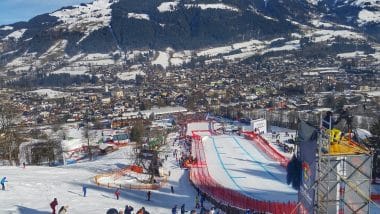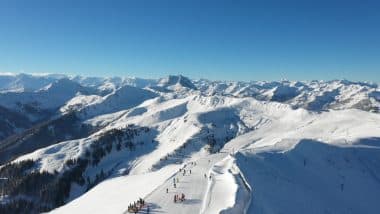Kitzbühel is a beautiful medieval town in the heart of the Austrian Tyrol with a truly huge ski area that spans three sectors. It’s best suited to intermediate and advanced skiers, and the opportunities to ski on the piste and do a lot of ground on the ski tracker are almost as big as the huge ski resorts of Paradiski and Trois Vallées in France.
When Kitzbühel is mentioned, anyone who follows ski racing or regularly watches Ski Sunday thinks of the Hahnenkamm, the name of one of the ski sectors of the ski area, but also of the nastiest and scariest downhill run in the World Cup. But in reality, apart from the one crazy January weekend on which the race takes place, Kitzbühel is a piste kitten that makes more meow than capoo.
The infrastructure of the ski town
The city’s ancient streets are home to an abundance of old guesthouses that have been converted into four- and five-star hotels, as well as a wide variety of restaurants, ranging from the obligatory gourmet cuisine to traditional eateries that are easy on the wallet. As in any big-name Austrian resort, the nightlife in Kitzbühel is top-notch, with the parties after the races in January being a special highlight (for those who can remember).
Kitzbühel’s medieval silver mining core with its strongly supported walls and delicate fresco paintings rightly deserves its reputation as the most beautiful ski town in Europe. The pedestrian-friendly Vorderstadt and the Hinterstadt, the city center within the heavy old city walls, are set against the backdrop of the jagged teeth of the spectacular Wilder Kaiser Mountains.
Judging by the clientele dressed in designers and fur coats, who rummage through the city’s shop windows but never quite make it to the mountain (and not even those who collect kilometers on the slopes), you might think that Kitzbühel is the most noble holiday resort in Austria. But even at the higher end of the list, prices don’t come close to the stratospheric heights of Courchevel or Zermatt.
The race week in Kitzbühel

Every year in January, the best skiers in the world gather here to compete on the Streif, the slope on which the Hahnenkamm takes place, on the mountain of the same name. At one point – the notorious Mausefalle – the track drops at a breathtaking 85 degrees, which is also about the speed that the racers reach in km/h. The Austrian superhero Franz Klammer, who has won here four times, once said: “Anyone who reaches the bottom safely and finishes the race is the winner.” Race week attracts thousands of international fans to the medieval city, and the atmosphere is electric, with live music stages, pop-up food village, and parties until the early hours of the morning.
Ski tourism in Kitzbühel
But in reality, Kitzbühel is more about the many, mostly intermediate slopes that seem to drag on endlessly. Even the Streif becomes a family descent when the jumps have been dismantled, the racers move on to the next event in their suits and the night owls have overcome their hangovers.
Despite great slopes and a beautiful base, Kitzbühel has one disadvantage as a world-class destination – the low altitude. The town is located at 800 m and the top lift at 2,000 m, so snow is usually best in the last week of January and the first three weeks of February.
Nevertheless, the ski resort is often the first of Austria’s non-glacier ski resorts to open, in most years as early as mid-October, and has a north-west orientation that preserves the snow on the higher slopes. Winter sports have enjoyed great popularity here since 1893, and the good winters have far exceeded the bad, which is also due to the considerable investment in snowmaking.
Which slopes are the best?

The slope possibilities in Kitzbühel are enormous – 233 km of slopes, including 39 km of unprepared ski routes, are spread over three different ski sectors: the Hahnenkamm (home of the Streif downhill run, where the famous Hahnenkamm World Cup ski race takes place), the Kitzbüheler Horn and the neighboring Bichlalm.
The ski area is best suited for intermediate and advanced skiers, and the runs are spectacular in good conditions. While the Kitzbühel ski area stretches across many mountains, none of them are above 2,000m – in a dry winter, sufficient snow cover can cause problems at these low altitudes, especially at lower altitudes.
For beginners, there are free lifts on the Hahnenkamm and others on the nearby Jochberg and in Reith, and there are also ski passes just for the Horn. But overall, it is not an ideal ski resort for beginners due to the uncertain snow conditions at low altitude.
The horn is too often dismissed as boring beginner’s territory these days, which is a bit unfair. At 2,000 m, it is the highest point of the ski area, which can be reached by gondola and cable car. You have the choice between a long, easy blue slope back to the city and some more interesting, ungroomed routes. From the summit there is also the possibility to descend into the Raintal on a long and beautiful red slope.
Aurach, a few kilometres up the valley from Kitzbühel in the direction of Jochberg, is the starting point for the Bichlalm. This small area is dedicated to freeride. It can be reached via a chairlift opened in 2015 and with a snow groomer that goes up to the Stuckkogel every 30 minutes. From there, various routes lead back to the valley.




